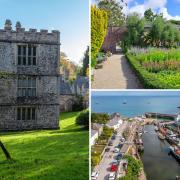Kurt Jackson is one of Britain’s most renowned – and hardest working - contemporary artists talks about his work and new projects

Kurt Jackson is one of Britain’s most renowned – and hardest working - contemporary artists. Carol Burns catches up with him ahead of his exhibition at his new gallery in St Just
I CAN remember first seeing the work of Kurt Jackson. A large square painting of Carbis Bay in a Nottingham gallery, it was a wonderfully quiet contented painting, and rendered the viewer as close to sitting on the beach in contemplation as one could get standing in the somewhat landlocked Midlands.
Somewhat surprisingly for such an established fine artist, Kurt Jackson describes himself as an environmentalist. But perhaps this becomes less surprising when we learn he studied zoology – and how this has fed into his work.
Enthusiastic and endlessly energetic, the year closes for him with his 2015 hugely successful touring exhibition Place, reaching its final destination in Bath and a new exhibition at his new gallery in St Just, and an accompanying book featuring paintings, drawings, prints, prose and poems traversing three decades. I thrive on being pushed and busy,’ he admits. When your work is about engaging with the natural world around us, there’s no shortage of material; there are not enough hours in the day.’ But he is far from complaining and looks upon the work as a series of overlapping projects. I need that variety; that eclectic mix in my life. All artists are paranoid that they will stagnate. By changing the subject matter and the media, my approach is changing all the time.’
Place, on show at the Victoria Art Gallery, Bath until 3 January saw him collaborate with 32 writers from a diverse range of backgrounds and resulted in a body of work that varies in scale from postcard-size pieces to large canvasses. Brought together, it reveals the physical diversity of the British landscape, and offers insight into the concept of place’ – that collective sense of identity, meaning, longing and nostalgia present within the British psyche. The project has been incredibly successful – in its first two days in Bath more than 1,700 people visited the exhibition.
This year also saw the opening of the Jackson Foundation gallery in St Just – where an exhibition of new work opens on 16 December. Wild Lives: Daily Encounters with the Animals of Cornwall features Jackson’s rendering of everything from fish and toads to foxes and basking sharks.
One of my favourites is a large canvas looking out to sea,’ he says. It’s quite an empty canvas and in the middle of this large expanse of grey there are the triangular fins of a basking shark. It’s very subtle, but on another level for anyone who has seen a basking shark in Cornwall, it speaks of the presence of these huge creatures.’
Born in Dorset in 1961 to a family of artists, Jackson went on to study zoology, before turning to fine art. Known for his painting, he has turned to a variety of other media, including sculpture, printmaking – and increasingly writing. His poetry has been published and his books have increasingly featured his own writing.
There are things you can say with words, that are harder to say in a visual language, and vice versa,’ he explains. I find they work very well together. I was always known for using text and calligraphy within my work and essentially that has grown and extended. I don’t write critically about my work, it’s either about what I am doing or where, or what I am looking at and where.’
In his new book A Kurt Jackson Bestiary, Jackson re-imagines the ancient art of the bestiary to encourage an appreciation of our natural environment. I see myself as an environmentalist. It’s my main concern. It’s the fundamental issue and springboard for everything else in my life,’ he says.
Bestiaries date back to medieval times when religious instruction promoted the study and interpretation of animal life, often with elaborate illustrations. Jackson’s contemporary bestiary extends this tradition, looking closely at everyday and lesser-known species of birds, insects, mammals and fish in order to stimulate a connection to the world around us. The book has got stuff that’s quite historic, the oldest images are 30 years old but they also go up to work that’s on gallery walls now,’ he says.
He is a long-term supporter of Cornwall Wildlife Trust and is currently taking part in their #MyWildLife campaign. He also supports Friends of the Earth and has been Artist-in-Residence on the Greenpeace ship Esperanza, at the Eden Project and at Glastonbury Festival since 1999. He is an Honorary Fellow of St Peter’s College, Oxford University and holds an honorary doctorate from the University of Exeter. Environmentalist can mean all sorts of things to all sorts of people,’ he adds. Yes, it’s about climate change, species loss and habitat loss but it’s also about being aware of how animals and plants in the world exist.’
Despite his ever-changing style, his work is immediately recognisable. It’s very much mine,’ he says. Whether I am working in an urban or rural situation or in a house or on a fishing boat, you can see the work is mine. I have always said that I am happy for my work to be accessible. I hate elitism and people feeling they are divorced from the work or that they don’t understand it. I don’t expect everyone to like it, but I want people to notice it and for it to speak to them in some way – I don’t want everyone to ignore it.’
Wild Lives: Daily Encounters with the Animals of Cornwall opens 16 December at Jackson Foundation Gallery, St Just TR19 7LB



























